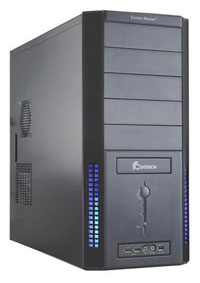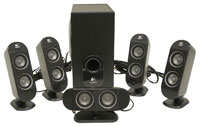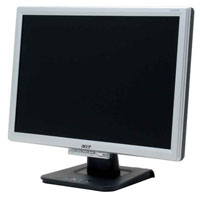Basic Configuration - Accessories
All of the components we've discussed so far tend to have more of an impact on overall system performance. What remains are the miscellaneous accessories that may not impact performance at all, but they do influence other areas of the computing environment. Personal preference will play a larger role in many of these components, so as always we would recommend people stick with what they like first and only branch out if you are looking to try something else. Most of the base selections can be used with any of the builds we will be putting together without any difficulty, and we will try to make note of any exceptions.
For optical storage, Blu-Ray and HD-DVD are still too expensive to warrant inclusion in a midrange computer, so we return to the venerable DVD+RW. Most companies now offer 18X burn speeds, which are barely faster than the old 16X maximum, and street prices bottom out at around $30. The LG GSAH22N includes all the standard features as well as 12X DVD-RAM support and works well with a variety of media, so it gets our recommendation. We're still waiting for reasonably priced SATA optical drives that can deliver similar overall quality, unfortunately.
 |
The computer case is one of the items that you will see a lot, but you really only have to work with it once or twice during the life of the typical computer (unless you upgrade frequently). Appearance is definitely an important consideration for many people, and what one person finds attractive another will find ugly or boring. Besides the appearance, the choice of case will also impact noise levels, cooling, and ease of installation. The cheapest cases tend to be made of thin steel, which gives them sharp edges internally and also makes them pretty flimsy. They will still suffice for most people, but we prefer slightly more expensive cases. Cooler Master has a large selection of reasonable midrange cases, and most of us find them to be easy to work with and reasonably attractive. Antec, In Win, Thermaltake, Apevia, Lian Li, and others offer alternatives worth considering, and if you are more budget minded the Rosewill brand is worth a look. We like cases that support 120mm fans (at least one) as they will typically offer better cooling with lower noise levels. Beyond that, remember to make sure your optical drive matches whatever case you choose.
 |
Of far more concern than the case is going to be the power supply you use, particularly in some of the upgraded midrange configurations. Getting a case with an included power supply will usually save you some money, and most power supplies rated at 350W or higher are sufficient for a midrange computer. Still, when you consider that you're spending over $1000 on all of the other components, we really hesitate to shave $40 or $50 off the total price by sticking with a low-end power supply. We've selected a reasonably priced 450W Fortron Source PSU as our basic recommendation, and that should be more than enough for any midrange computer, other than for serious overclocking. Fortron Source is a well-regarded PSU manufacturer, and they are often used as the basis of OEM power supplies. The only potential drawback of the AX450-PN is that it only has a 70% efficiency rating, but if you want a higher efficiency power supply you will have to spend more money. We're more concerned about power supply noise levels than efficiency, and while the two are related the 120mm fan used in the FSP helps to keep noise levels down. If you're willing to spend a bit more money and you want the best of both worlds - quiet and efficient - SeaSonic gets a strong recommendation. They tend to cost more for lower wattage ratings, but a SeaSonic S12-330 performs better than most other 400-450W power supplies. OCZ, Enermax, and several other companies also make some very good high-end power supplies, which we will discuss a bit further in the overclocking configuration, but SeaSonic remains one of the quietest (short of purchasing a fanless PSU).
 |
Keyboard, mouse, and speakers are three items where you can either go for the bare minimum cost and functionality, or you can spend a lot of money for extra features. We have selected what we feel are good options for all three areas, and it would be hard to find anything that's truly "better" without spending more money. Our performance configuration will include better speakers, but we didn't feel the need to upgrade the keyboard or mouse on any of the builds. If you want to get a wireless keyboard and mouse, our advice is to spend more money rather than less. The $30-$40 packages generally don't perform as well as we would like, so unless you absolutely want wireless input devices, we prefer to spend the extra money elsewhere.
 |
The last accessory is the display, and as we have said on many occasions we would much rather have a very nice display with a decent computer than to have an excellent computer with a lousy display. LCD prices have continued to drop, although even the cheapest 19" models still tend to cost just under $200. The 19" LCDs are still a good option, but for the extra money we would prefer to get a 20" LCD that comes with a higher resolution. Most of us also prefer widescreen LCDs these days, and although there are a few gaming titles that continue to cause irritation by not natively supporting widescreen resolutions, moving forward WS support should become commonplace. Outside of games, watching widescreen movies is definitely preferred, and we enjoy the extra screen width on the Windows desktop as well. Looking at the various 20" widescreen displays that are available, Acer once again has one of the best price/performance offerings. ViewSonic, BenQ, Samsung, and several other companies make similar LCDs, but they all cost a bit more and it is difficult to say that they actually look much better than the Acer model. For $230, most people will be very happy with the Acer AL2016W.
For the operating system, we selected Windows XP Media Center Edition 2005. It only costs slightly more than XP Home, and it allows you to upgrade to Vista Home Premium as we mentioned earlier. The DVR functionality may not be necessary, but it doesn't hurt either, and the only features that XP Pro adds (i.e. hard drive encryption) are not used by most people.














43 Comments
View All Comments
JarredWalton - Sunday, January 21, 2007 - link
Some of the PCs are kept up to date for gaming parties and the like. Others are just mostly sitting around waiting for me to test something on an older platform or whatever. Others are basically spare parts. In the winter, I turn on a lot of them to provide heat - I only have electric heaters anyway, so whether I'm putting the electricity into the heaters or into PCs doesn't make much difference to me. I run Folding@Home in such cases to increase heat output, and if the house starts getting too warm I shut down systems. :)chrnochime - Friday, January 19, 2007 - link
Basic Config - AccessoriesBoth times that Fortron appeared, it was written as "Fotron". FSP would probably appreciate that you spell their name correctly....
JarredWalton - Friday, January 19, 2007 - link
Awesome! I've been misspelling their name for years and this is the first time anyone has corrected me. Oops! Thanks -- I will see to it that they don't make that mistake again. :-)JarredWalton - Friday, January 19, 2007 - link
Speech recognition. "they" = "I"noxipoo - Friday, January 19, 2007 - link
should be around $1500.screech - Friday, January 19, 2007 - link
basic midrange page:" With either of the above systems, you should easily be able to run all current applications, along with Windows Vista, with one possible exception: games. You can even run all current games,"
Perhaps a little rewording is in order? ;)
JarredWalton - Friday, January 19, 2007 - link
Not sure what you mean - maybe I'm just blind. Basically, you can run all current games, but not at maximum detail, hence it's a "possible exception".dqniel - Friday, January 19, 2007 - link
Rosewill PSUs? Absolutely awful. OCZ S.O.E. ram? Horrible track record with C2D chipsets and a poor price to performance ratio. G.Skill "HK" series RAM for the OCing system? 2x1GB kits using Micron D9 are available for the same price. A $267 Super Talent kit on Newegg for example. Asus P5B-E 1.02 motherboard? Not even available in the U.S. OCZ GameXStream PSU? Such horrible voltage ripple problems that I wouldn't trust it in a budget rig. The Corsair 520w or Zalman 600w would be much better choices.I'm confused as to how this thing got past quality control and was published.
JarredWalton - Friday, January 19, 2007 - link
Several editors felt the G.Skill RAM was a good choice, but the Super Talent is arguably just as good if not better. Considering the G.Skill is now out of stock, I'll switch the RAM to the Super Talent - which is not Micron D9 memory as far as I'm aware, but still uses Micron chips and performs quite well (unless you're looking at some other ST memory?). The OCZ S.O.E. mostly suffered from early P965 BIOS issues, and with the rebate it comes in as very good RAM for a relatively low price. If you don't like rebates, we would suggest other DDR2-800 RAM price at around $200, which will perform about the same (within 2% most likely). As for the rest...There are about five different 700W PSUs available that are all based off the 700W Fotron Source. OCZ GameXStream is the cheapest at present, and despite your concerns with the "horrible voltage ripple" we have found the PSU to work extremely well in various systems. The overall experience most people have had with this PSU is very good - no product is perfect, and there will always be a few bad units out there - and for the price it's difficult to say that any PSU is universally better. You can get quieter PSUs (with lower wattage ratings - although those are mostly hype), and the Corsair 520W you mention is a good PSU. Is it better, though? That's difficult to say.
The Rosewill PSU is in a different boat. Every time anyone recommends a PSU from some lesser brand, criticisms are sure to come. Rosewill PSUs in our experience are decent, and while Deer Electronics or Solytech or whoever may be the OEM, companies can and do get better. I've got one of the Rosewill 600W PSUs running a system and I've had no complaints with it. I haven't tried to overload the PSU to make it fail, but it appears to be about as good as several other ~550W PSUs I have (in terms of efficiency) and it's quite a bit cheaper. It's also a bit more noisy, but when you've got CrossFire X1900 GPUs most other fans are quiet by comparison. When it can run a CrossFire setup without any issues, that's pretty good for a $75 PSU. Of course, I'm not a PSU reviewer, but http://www.jonnyguru.com/review_details.php?id=48">JohnnyGuru took a look at a 500W Rosewill so maybe you'll trust his results? Not bad for a budget PSU, and it's probably safe to say the 600W listed in this BG is of similar quality to their 500W unit.
Finally, for the motherboard I've listed the DS3 and the P5B-E, on the recommendation of Gary as he tends to do most of our motherboard reviews and he's tried all of the boards. My understanding was that the 1.02G is available in the US, but perhaps you're right. The P5B-E still offers a few features other boards lack at that price point, so depending on whether you prefer better OC'ing (DS3) or features will determine which board is right for you.
If singling out 5 components out of 31 that you dislike turns an article into a horrible mess that's not worthy of publication, I'm sorry to disappoint. I can't say for certain that every one of these components is best in class and will work with every possible system configuration out there (i.e. motherboards can be picky about RAM at times), but I can say that the configurations listed will work very well according to our testing of the various parts. Most of the criticisms you've brought up will hardly make a difference on the final result.
dqniel - Friday, January 19, 2007 - link
Let me first state that perhaps I exaggerated a bit. I didn't mean to imply that the guide was "a horrible mess." Simply put, I think the guide is below Anandtech's standards in terms of having nearly perfect product selection in the given price range. Why settle for "...will hardly make a difference on the final result" when you can squeeze out that extra little bit of performance and stability for your money?I'm sticking by my Super Talent remark in that it has D9GMH chips: http://www.newegg.com/Product/Product.asp?Item=N82...">http://www.newegg.com/Product/Product.asp?Item=N82... (this particular model)
Secondly, I'm glad that you could inform me that most of the S.O.E. problems have been fixed by BIOS updates. I'm sure either the S.O.E. or similarly priced Adata would be perfect choices for the rigs.
As far as the PSUs are concerned- as I'm sure you know, most PSU companies will use varying OEM manufacturers from model to model. The particular Rosewill PSU you chosen, because of the poor choice of OEM manufacturer, for the 600w unit is well below the standards of other budget PSUs such as the Enhance GH models available at the reputable www.ewiz.com. Secondly, there is no reason to get a 700w PSU for the system you suggested even with heavy overclocking thrown into the mix. Power consumption is blown out of proportion and quality is greater than quantity since most companies' units don't actually meet their specified outputs. Because of this, a $120 Corsair HX or $120 Zalman 600w would be a better choice. Adequate power with better quality in terms of ripple while costing less seems like a logical choice. Sure, ripple won't cause any performance problems in the short term, but Jonnyguru and others have stated that in the long run it leads to the death of sensitive components such as RAM. The FSP Epsilon-based units are some of the worst available (with the exception of the Zalman unit) in terms of putting out dangerous ripple.
The P5B-E 1.02 was renamed after the article you guys published. It was released overseas as the P5B-E Plus and is impossible to find in the states without paying ludicrous amounts. The Gigabyte DS3 and P5B-E Deluxe are both fantastic and widely available, however.